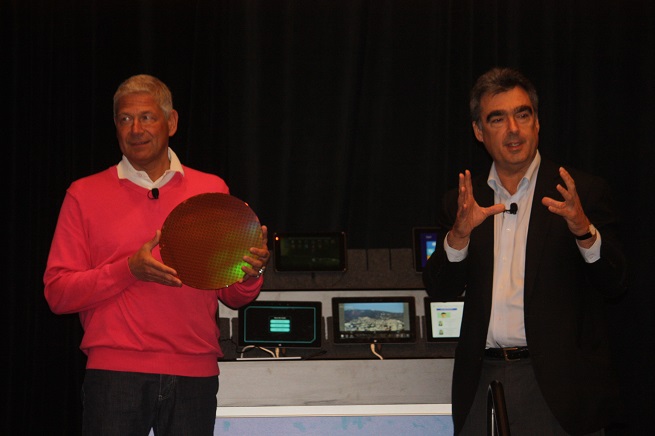SAN FRANCISCO — Google and Intel announced four new models of Chromebooks today that use the codenamed Haswell processors that Intel released earlier this summer. The new models from Hewlett-Packard, Acer, Asus, and Toshiba were revealed at the Intel Developer Forum today.
The ChromeBooks have battery lives at about nine or 10 hours, and they have a range of display sizes. They look like normal thin laptops, but they don’t run Microsoft Windows. Instead, they sport Google’s Chrome OS. The Chromebooks are expected to cost under $300 for Wi-Fi-only models. Sales of Chromebooks have been strong; the No. 1 laptop on Amazon.com is a Chromebook.
Schools are big adopters. More than 5,000 schools in 20 percent of school districts in the U.S. are using Chromebooks for students.
Of course, Windows-based laptops are also expected to be big sellers this fall. Kirk Skaugen, the senior vice president of PC clients at Intel, said in his keynote that Intel has had 141 design wins for Bay Trail, a new 22-nanometer chip family that is a successor to the Haswell family and is aimed at tablets and laptops. Laptops based on Bay Trail will range in price from $200 to $350.
Meanwhile, Skaugen said next year’s 14-nanometer chip, codenamed Broadwell, will consume 30 percent less power than Haswell chips.
Intel also showed its latest progress with “perceptual computing,” or going beyond the keyboard and mouse to interface with computers. Perceptual tech includes 3D gesture controls, face recognition, eye-tracking, voice recognition, and touch.
During a keynote, Kirk Skaugen, the Intel senior vice president in charge of PC clients, showed off a new $200 Senz3D camera from Creative. It supports apps that use Intel’s perceptual computing software development kit.
Intel’s 14-nanometer Broadwell chip, coming for Ultrabooks in late 2014, will support integration of a 3D camera directly into the bezel of a laptop, Skaugen said. That’s a lot of progress since 2012, when the company announced the perceptual computing initiative to move beyond the mouse and keyboard.
Intel uses a 720p RGB camera from SoftKinetic that does Kinect-like motion detection. The camera can detect motion at a range of 6 inches to 3 feet.
Intel loves these new technologies because they chew up computing cycles and create demand for its latest processors. Doug Fisher, vice president of software and services, said the perceptual computing SDK is the most popular in Intel’s history, with 25,000 downloads.
VentureBeat's mission is to be a digital town square for technical decision-makers to gain knowledge about transformative enterprise technology and transact. Learn More

